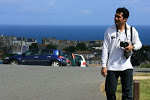Land of the Goddess

Pura Tanah Lot, Bali
“And this day, I shall bestow on humankind, a piece of land as a magnificent house for My Goddesses”.
For some, that land is Bali. As I first set my foot on Kuta Beach Bali, the gusty sea breeze slapped on my face. It smelled different. In fact, everything seemed different despite that we were only 3 hours away from KL. And here I am, standing, completely dumbfounded in the middle of a gazillion tourists – Aussies with surfboards, quirky Javanese with non-matching socks and stimulating beach girls in 2-piece. The island as though alive, fuelled by tourism. Even the stray dogs seemed overweight and healthy, being incessantly fed with tourists’ Big Mac’s leftovers.
This cross-culture between Hindu and Buddha, explains why the Pura (the temple) portrays so much resemblance of the two religions – the statues, the monkey monuments, and most amazingly, the intricate stone carvings that lavishly decorated the walls of every Balinese house. Shops instantly transformed into discos by dawn, beaming erratic multicolour lights to the sky, deafening the passersby. But, such scene appears so uncommon among the villagers of Tegalalang, where the chirps of sparrow and contoured green rice terraces simply gives colour to what this mystical island is all about. Here are some quick facts about Bali:
1. Every village, there are 3 puras (temples) for their goddesses – Brahma, Vishnu, and Siva
2. Women in menstruation are advised not to enter pura for fear of “emotional breakdown” –“lemah semangat”
3. Rp4,000 (RM2.00) is only good for a 500ml mineral water.
4. Penis-shaped ashtrays range between Rp15,000 to Rp120,000, depending on the size.
5. Before you wet in your pants, get your vocabulary right. “Kamar kecil” is toilet, in Indonesia.
6. Contrary to KL drivers, honking is not a sign of “Woi! Mangkuk hayun. Lesen kopi ka!”


